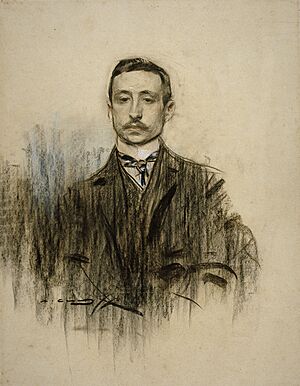Eduardo Chicharro y Agüera facts for kids

Eduardo Chicharro y Agüera (born June 18, 1873, in Madrid; died May 24, 1949, in Madrid) was a famous Spanish painter. He painted many different kinds of art, but he was especially known for his beautiful portraits of women. His son, Eduardo Chicharro Briones, became a well-known poet.
Contents
Biography
Early Life and Training
Eduardo's father was a craftsman who worked with glass. Even though his father passed away when Eduardo was only two years old, his love for art inspired Eduardo. His mother encouraged this passion.
When he was very young, Eduardo started taking art classes at the School of Arts and Crafts. At fifteen, he joined the Real Academia de Bellas Artes de San Fernando. There, he learned from important artists like Joaquín Sorolla, Manuel Domínguez Sánchez, and Carlos de Haes. He later said that Carlos de Haes was the biggest influence on his painting style.
Artistic Achievements
Eduardo Chicharro showed his art in many exhibitions, both in Spain and other countries. In 1896, he received an honorable mention at the National Exhibition of Fine Arts. In 1899, he won a Second Class prize for his painting "Uveras," which means "grape sellers."
In 1900, he received a scholarship that allowed him to study at the Academia de España in Rome, Italy. This was a great opportunity for him to learn and grow as an artist.
In 1904, he won a First Class prize at the National Exhibition for "The Poem of Arminda and Rinaldo." This was a large painting with three parts, showing characters from a famous poem called Jerusalem Delivered. That same year, he married María Briones and moved to Ávila. He won another First Class prize in 1908 for his painting "The Three Wives." His art was also shown in international exhibitions in cities like Munich and Liège.
Founding the Asociación de Pintores y Escultores
In 1910, Eduardo Chicharro helped start a group called the Asociación de Pintores y Escultores (Association of Painters and Sculptors). He was the first president of this important art group. Two years later, the Association began an annual art show called "Salón de otoño." This show was inspired by a similar famous art show in Paris.
Life in Rome and Later Years
In 1912, Eduardo was chosen to be the Director of the Academia Española de Bellas Artes de Roma. This was the Italian branch of the Real Academia de San Fernando. He and his family lived in Rome until 1925. While in Rome, he became very interested in Indian culture and the writings of Rabindranath Tagore. During this time, he painted "The Temptation of Buddha," which he considered one of his best works.
In 1926, the Spanish government gave Chicharro y Agüera's painting "Pygmalion" to the International Labour Office in Geneva. The painting was later covered up for many years. However, in 2007, "Pygmalion" was rediscovered and put back on display for everyone to see.
After returning to Madrid, he became a professor at the Escuela Superior de Bellas Artes. He was also appointed Inspector General of the School of Arts and Crafts and later became its Director in 1934. During the Spanish Civil War, he lived with his friend, the painter Luis Gallardo Pérez. His friend's influence helped him use brighter colors in his art. After the war, he returned to his teaching and directing roles. In 1944, he received a special award called the Civil Order of Alfonso X, the Wise.
See also
 In Spanish: Eduardo Chicharro y Agüera para niños
In Spanish: Eduardo Chicharro y Agüera para niños

